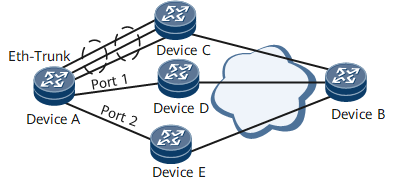Global UCMP Application
DeviceA has three outbound interfaces that support global UCMP: Eth-Trunk 1, Port 1, and Port 2. Eth-Trunk 1 is a logical interface that consists of three GE interfaces. The bandwidths of the three outbound interfaces are 3 Gbit/s, 1 Gbit/s, and 1 Gbit/s. Three IPv4 equal-cost routes are available between DeviceA and DeviceB.

When UCMP is not enabled on the three interfaces, their traffic ratio is 1:1:1, irrespective of the bandwidth ratio.
After global UCMP is enabled, traffic from DeviceA to DeviceB is load-balanced on the three outbound interfaces, and the traffic ratio approaches the bandwidth ratio 3:1:1.
When a member interface of Eth-Trunk 1 is shut down, the bandwidth of Eth-Trunk 1 changes to 2 Gbit/s and accordingly the bandwidth ratio of the three outbound interfaces is 2:1:1 for load balancing.
When interfaces support UCMP, the bandwidths of equal-cost routes are displayed in the FIB table. By calculating the bandwidth ratio of interfaces, you can see whether the bandwidth ratio approaches the traffic ratio. In this way, you can learn whether UCMP functions normally.